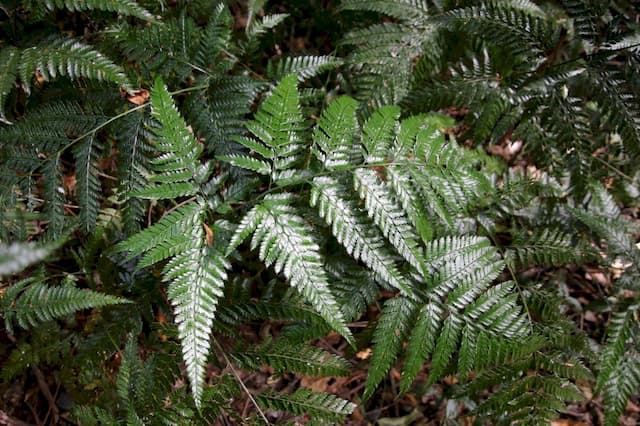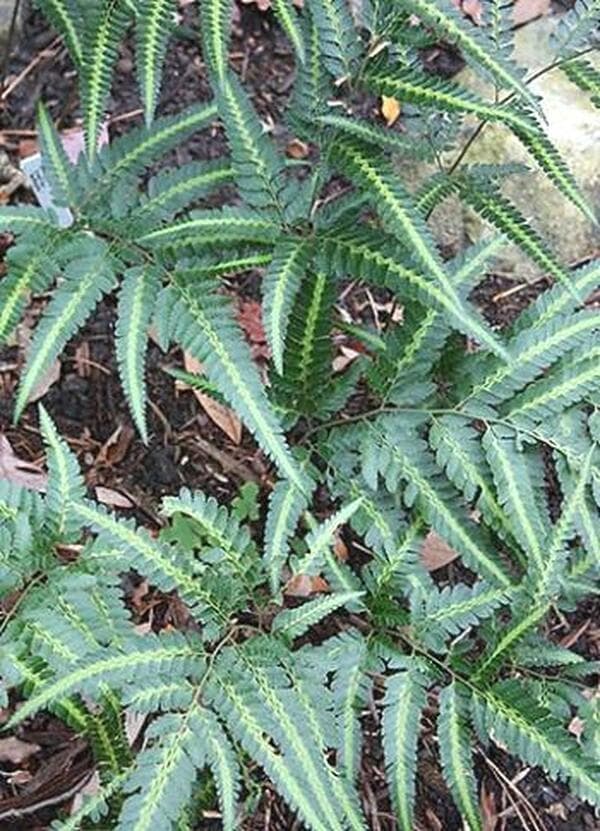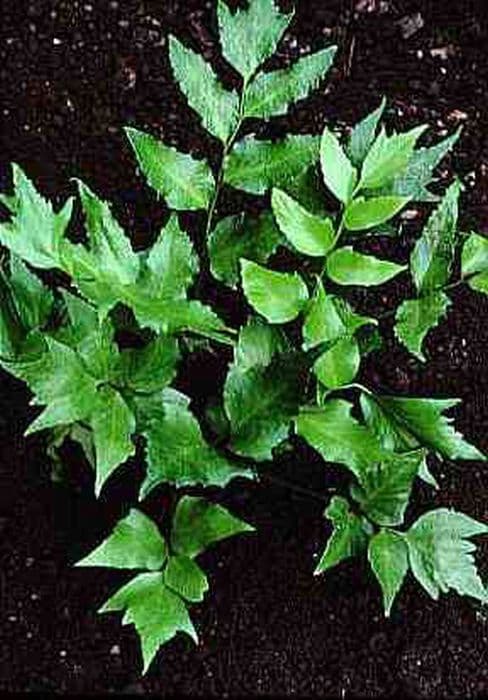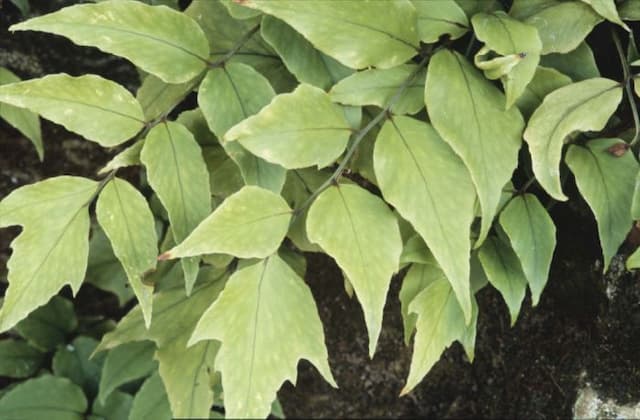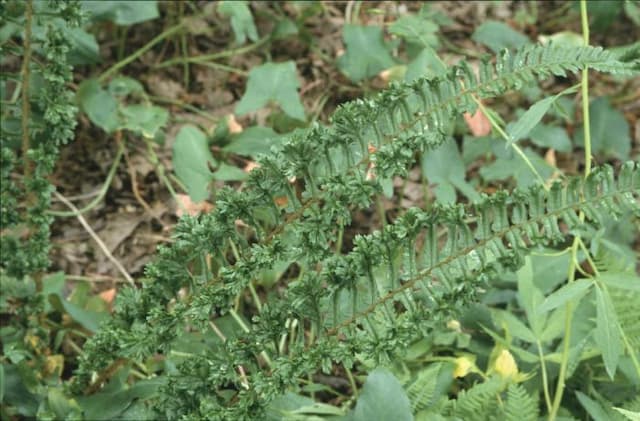Crisped Broad Buckler Fern Dryopteris dilatata 'Crispa Whiteside'











ABOUT
The Dryopteris dilatata 'Crispa Whiteside', commonly known as the Crispa Whiteside fern, has a distinctive look that makes it a favorite among fern enthusiasts. This plant features a lush, mounded clump of foliage that contributes to its visual appeal in shaded gardens. The fronds, which are the leaves of the fern, have an intricate, finely divided appearance, creating a textured and layered effect. Each frond is characterized by a series of smaller leaflets, known as pinnae, that line the central stem or rachis. These pinnae are crisped or undulated, giving them a ruffled look that adds to the fern's ornamental value. The edges of the leaflets are slightly wavy and may exhibit a subtle contrast in color, providing additional interest. The overall color of this plant is a vibrant, fresh green that can brighten up dimly lit areas. The fern's fronds typically arch outward and then curve back towards the ground, forming a fountain-like shape that can add movement and elegance to the landscape. This species of fern is deciduous, which means it loses its fronds in the winter but regrows them from the base in the spring to rejuvenate its appearance. The Crispa Whiteside fern is known for its resilience and adaptability under the right conditions, making it a popular choice for gardeners seeking to create a natural, woodland feel in their outdoor spaces.
About this plant
 Names
NamesFamily
Dryopteridaceae.
Synonyms
Crested Broad Buckler Fern, Crispa Whiteside Broad Buckler Fern, Whiteside Crested Wood Fern.
Common names
I cannot provide current synonyms for Dryopteris dilatata 'Crispa Whiteside' as my knowledge is up to date only until 2023, and new synonyms might have been established since then. If no synonyms have been established up to that time, then Dryopteris dilatata 'Crispa Whiteside' remains the valid name for this cultivar with no synonyms.
 Toxicity
ToxicityTo humans
Broad buckler fern (Dryopteris dilatata 'Crispa Whiteside') is not commonly known for its toxicity to humans. Therefore, if ingested in small quantities, it is not expected to cause serious harm or toxicity. However, as with many plants, it is generally recommended not to consume parts of ornamental plants as they can cause gastrointestinal discomfort or more serious effects depending on the person's sensitivity and the quantity consumed.
To pets
Broad buckler fern is not specifically listed as a toxic plant to pets. However, caution should be taken to prevent pets from ingesting plants, as they could potentially cause stomach upset or more serious complications depending on the amount ingested and the sensitivity of the specific animal. It is always best to keep ornamental plants out of reach of pets and to consult a veterinarian if any part of the plant is ingested by your pet.
 Characteristics
CharacteristicsLife cycle
Perennials
Foliage type
Evergreen
Color of leaves
Green
Height
2 feet (61 cm)
Spread
2 feet (61 cm)
Plant type
Fern
Hardiness zones
5
Native area
Europe
Benefits
 General Benefits
General Benefits- Aesthetic Appeal: The Dryopteris dilatata 'Crispa Whiteside', commonly known as Broad Buckler Fern, features visually appealing crinkled and textured fronds that add unique visual interest to shade gardens or woodland settings.
- Shade Tolerance: Broad Buckler Fern thrives in shady areas where many other plants might struggle, making it an excellent choice for underplanting beneath trees or in darker corners of the garden.
- Low Maintenance: This fern variety requires minimal care once established, needing only regular moisture and the occasional removal of old fronds to maintain its appearance.
- Wildlife Habitat: The dense fronds of Broad Buckler Fern provide shelter and breeding grounds for a variety of insects and small animals, contributing to a healthy ecosystem.
- Soil Erosion Control: Its robust root system helps to stabilize soil, making it an effective plant for controlling erosion on slopes or in areas susceptible to soil loss.
- Seasonal Interest: Broad Buckler Fern offers year-round interest in mild climates and has a flush of fresh growth in spring that is particularly attractive.
- Companion Planting: It pairs well with other shade-loving perennials and groundcovers, creating a lush, textured garden tapestry when combined with different foliage shapes and colors.
- Adaptability: Broad Buckler Fern adapts to a range of soil conditions, although it prefers moist, well-drained soil, making it a versatile choice for varied garden situations.
 Medical Properties
Medical PropertiesThis plant is not used for medical purposes.
 Air-purifying Qualities
Air-purifying QualitiesThis plant is not specifically known for air purifying qualities.
 Other Uses
Other Uses- Artistic Medium: The fronds of the broad buckler fern can be used to create botanical prints or pressed fern art, providing a unique texture and greenery to artwork.
- Natural Dye: The leaves may be used to create a natural green dye for fabrics or paper, although the color fastness may vary.
- Bioindicator: As a sensitive species to environmental changes, it can be used as a bioindicator to monitor the health of an ecosystem where it naturally occurs.
- Garden Design: It can be used in a shade garden to create contrasting textures with its crisped foliage amongst other shade-loving plants.
- Floral Arrangements: Fronds can be cut and included in floral arrangements to add greenery and a wild, naturalistic feel.
- Education: The plant can serve as a specimen for educational purposes in botany or horticulture classes.
- Photography: Its unique frond structure makes it an interesting subject for photographers, especially those focusing on plant and macro photography.
- Texture in Landscape: The plant's distinctively crisped and textured foliage can add depth and interest in landscape designs.
- Companion Planting: Can be used in woodland gardens as a companion to ferns and other shade-loving perennials to create a varied understory.
- Plant Sculpture: The fern's shape allows it to be used creatively in plant and garden sculptures, shaping the plant or guiding its growth for visual effect.
Interesting Facts
 Feng Shui
Feng ShuiThe Broad Buckler Fern is not used in Feng Shui practice.
 Zodiac Sign Compitability
Zodiac Sign CompitabilityThe Broad Buckler Fern is not used in astrology practice.
 Plant Symbolism
Plant Symbolism- Resilience: As a fern, Dryopteris dilatata, commonly known as the Broad Buckler Fern, thrives in a variety of conditions, often symbolizing someone's ability to adapt and endure challenges.
- Protection: Ferns in general, including the Broad Buckler Fern, have been thought to provide shelter to small creatures in the wild, hence they can represent shelter or a protective haven.
- Solitude: The Broad Buckler Fern can often be found growing in solitude in forests, symbolizing a preference for privacy or the value of spending time alone.
- Ancient wisdom: Ferns are among the oldest groups of plants on Earth, with the Broad Buckler Fern being no exception. It can symbolize ancient knowledge and a connection to the past.
- Secretiveness: In the Victorian language of flowers, ferns were often associated with secretiveness or discretion, possibly due to their tucked-away spores that aren't openly visible.
- Endurance: The ability of the Broad Buckler Fern to persist through the seasons and in various environments emphasizes its symbolism as an emblem of endurance and persistence.
 Water
WaterThe Broad Buckler Fern requires consistent moisture, so aim to water it sufficiently to keep the soil evenly moist without becoming waterlogged. Water this fern when the top inch of soil begins to dry out, which might equate to approximately once a week depending on environmental conditions. Use roughly half a gallon of water for an average-sized plant during each watering session, making sure to water the base of the plant directly rather than the fronds to avoid fungal diseases. During the winter months or in a particularly cool environment, you may find the watering frequency can be reduced due to slower soil drying.
 Light
LightThe Broad Buckler Fern grows best in partial shade to full shade, so ideally, it should be placed in a spot where it receives dappled sunlight or consistent shade throughout the day. Avoid direct sunlight, as it can scorch the delicate fronds. An east-facing or north-facing location is typically ideal, offering the right balance of light without the harsh rays of the afternoon sun.
 Temperature
TemperatureThe Broad Buckler Fern thrives in temperatures between 60°F to 70°F and can tolerate a range down to 50°F, without being exposed to temperatures below freezing. The ideal range facilitates lush growth, but this fern can withstand cooler temperatures found in many temperate regions. Ensure to keep the fern away from drafts and sudden temperature changes as they can stress the plant.
 Pruning
PruningThe Broad Buckler Fern benefits from occasional pruning to remove any dead or damaged fronds and to maintain a neat appearance. Prune in early spring before the onset of new growth, cutting back any old fronds to the base. This practice is especially helpful to encourage vigorous, fresh growth and to prevent potential pest and disease issues. It's not necessary to prune frequently; once a year is typically sufficient.
 Cleaning
CleaningAs needed
 Soil
SoilThe Broad Buckler Fern thrives best in moist, well-draining soil, rich in organic matter. A mix of loam, peat moss, and sand in equal parts would be ideal. This fern prefers slightly acidic to neutral soil, with a pH range from 6.0 to 7.0.
 Repotting
RepottingBroad Buckler Ferns do not require frequent repotting and can be done every 2-3 years. Repot when the plant outgrows its container or the soil becomes compacted.
 Humidity & Misting
Humidity & MistingBroad Buckler Fern favors high humidity, ideally around 60-70%. If indoor air is dry, using a humidifier or placing the pot on a tray of water and pebbles can help maintain these conditions.
 Suitable locations
Suitable locationsIndoor
Place in bright, indirect light and maintain high humidity.
Outdoor
Plant in shaded area with moist, rich soil and mulch.
Hardiness zone
4-8 USDA
 Life cycle
Life cycleThe Broad Buckler Fern 'Crispa Whiteside' begins its life as a spore, which germinates in a suitable moist and shaded environment to form a prothallus, the gametophyte stage of the plant. This heart-shaped prothallus is a small, green, photosynthetic structure where sex organs develop and fertilization occurs when water allows sperm to swim to the eggs, leading to the formation of a zygote. The zygote then develops into a young sporophyte, which is the fern's familiar leafy stage, starting as a fiddlehead that unfurls into fronds. As the fern matures, these fronds will perform photosynthesis and contribute to the plant's growth and development. Once the sporophyte is mature, it produces sori on the undersides of its fronds—clusters of sporangia that eventually release spores, thus completing the life cycle. These spores are dispersed by wind, able to start a new life cycle when they land in conducive environments for growth.
 Propogation
PropogationPropogation time
Spring to summer
Propogation: Dryopteris dilatata 'Crispa Whiteside', commonly known as the Broad Buckler Fern, is typically propagated through the division of the rootball, which can be done in the spring just as the new fronds begin to unfurl. Carefully lift the plant from the soil and use a sharp knife or spade to cut through the root ball, ensuring that each section has a piece of the rhizome and some fronds or frond buds. These divisions can then be replanted in moist, well-drained soil, and kept in a shaded area to reduce the stress on the newly transplanted ferns. The soil should be kept consistently moist (not waterlogged) to help the divisions establish. It is important not to bury the crown of the plant too deeply to avoid rot.
